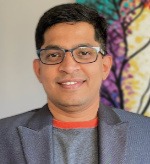Kiran Nakka, Ph.D.
Assistant Professor
The Ohio State University College of Medicine
Department of Physiology & Cell Biology
333 W. 10th Avenue
Columbus, Ohio 43210
Office: 5152 Graves Hall
Email: nakka.7@osu.edu

Education & Training:
National Centre for Cell Science, India, PhD
Ottawa Hospital Research Institute, Canada, Postdoctoral Fellow
Research Interests:
The focus of our laboratory’s research is to unravel the intricacies of inflammation-associated epigenetic programming within satellite cells, the tissue-resident muscle stem cells (MuSCs). Satellite cells possess extensive regenerative capacity and depletion of MuSC pool during chronic inflammation impairs repair and regeneration of damaged muscle fibers, ultimately contributing to muscle loss. In various diseases inflammation is characterized by the infiltration of a repertoire of immune cells in to the muscle tissue. In the presence of inflammatory immune cells and their secreted cytokines, MuSCs undergo alterations in their gene expression patterns. Our previous studies demonstrated that epigenetic factors prime MuSCs for inflammation during muscle regeneration and that inflammatory cytokines in the niche epigenetically manipulate MuSC activation and exhibit selective proteome usage in the presence and absence of inflammatory cues. Using high-throughput genome-wide association studies and single-cell approaches, we aim to elucidate the transcriptional and post-transcriptional gene regulatory networks that govern MuSC maintenance in the context of inflammation.
Selected Publications:
- Nakka K, Hachmer S, Mokhtari Z, Kovac R, Bandukwala H, Bernard C, Li Y, Xie G, Liu C, Fallahi M, Megeney L, Gondin J, Chazaud B, Brand M, Zha X, Ge K, Dilworth F J. JMJD3 activated hyaluronan synthesis drives muscle regeneration in an inflammatory environment. Science 2022, 377:666-669.
- Li Y*, Nakka K*, Oleander T, Gingras-Gelinas P, Wong MK, Robinson DCL, Bandukwala H, Neyret O, Brand M, Blais A and Dilworth F J. Chromatin and transcription factor profiling in rare stem cell populations using CUT&Tag. Star Protocols Vol 2, Issue 3, 17 Sept 2021 * Equal author
- Robinson DCL, Ritso M, Nelson GM, Mokhtari Z, Nakka K, Goldman SR, Park PJ, Mounier R, Chazaud B, Brand M, Adelman K, Dilworth FJ. Negative Elongation Factor (NELF) Regulates Muscle Progenitor Expansion for Efficient Myofiber Repair and Stem Cell Pool repopulation. Dev Cell 2021 56, 1-16.
- Nakka K, Kovac R, Wong MM, Dilworth FJ. Intron Retained, Transcript Detained: Intron Retention as a Hallmark of the Satellite Cell State. Dev Cell 2020 Jun 22; 53(6):623-625.
- Wu Q, Heidenreich D, Zhou S, Ackloo S, Krämer A, Nakka K, Lima-Fernandes E, Deblois G, Duan S, Vellanki RN, Li F, Vedadi M, Dilworth J, Lupien M, Brennan PE, Arrowsmith CH, Müller S, Fedorov O, Filippakopoulos P, Knapp S. A chemical toolbox for the study of bromodomains and epigenetic signaling. Nat Commun. 2019 Apr 23;10(1):1915.
- Brand M, Nakka K, Zhu J, Dilworth FJ. Polycomb/Trithorax Antagonism: Cellular memory in stem cell fate and function. Cell Stem Cell. 2019 Apr 4;24(4):518-533.
- Nakka K, Ghigna C, Gabellini D, Dilworth FJ. Diversification of muscle proteome through alternative splicing Skeletal Muscle. 2018 Mar 6;8(1):8.
- Faralli H, Wang C, Nakka K, Benyoucef A, Sebastian S, Zhuang L, Chu A, Palii CG, Liu C, Camellato B, Brand M, Ge K and Dilworth FJ. UTX demethylase activity is required for satellite cell-mediated muscle regeneration. J Clin Invest. 2016 Apr 1;126(4):1555-65.
- Nakka K, Chaudhary N, Joshi S, Bhat J, Singh K, Chatterjee S, Malhotra R, De A, Santra MK, Dilworth FJ and Chattopadhyay S. Nuclear matrix-associated protein SMAR1 regulates alternative splicing via HDAC6-mediated deacetylation of Sam68. Proc Natl Acad Sci U S A. 2015 Jun 30;112(26): E3374-83.
- Chaudhary N*, Nakka K*, Maulik N, and Chattopadhyay S. *Equal Contribution. Epigenetic manifestation of metabolic syndrome and dietary management. Antioxid Redox Signal. 17(2), 2012: 254-281. * Equal author
